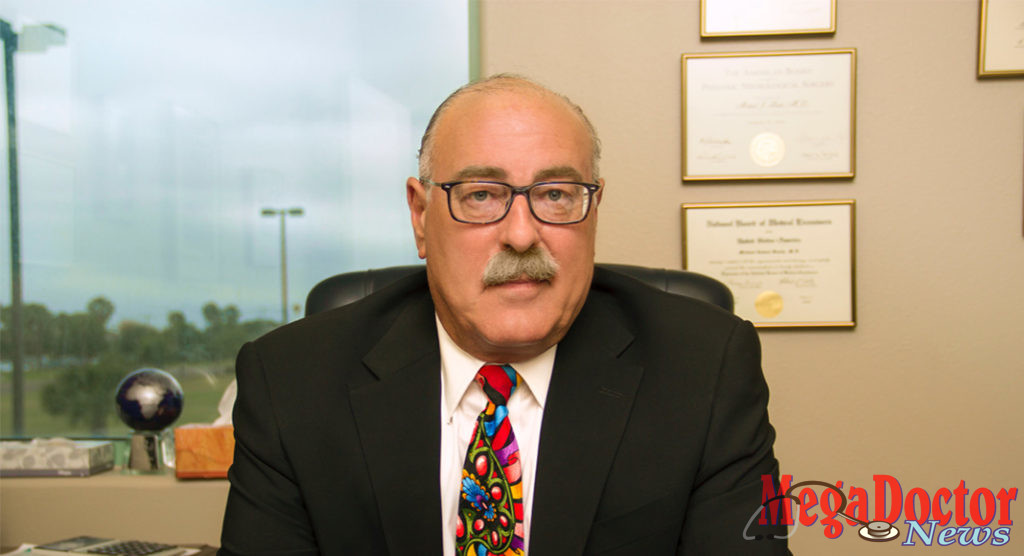Dr. Michael Burke, Board Certified Neurosurgeon, performs the first Endoscopic Clipping and Cauterization of Arteries for removal of a tumor and helps pediatric patient thrive.

Mega Doctor News
Edinburg, TX — The vision and heart to advocate for a pediatric patient in need is what drove Dr. Michael Burke, Board Certified Neurosurgeon, to come up with a unique surgical procedure to help his patient have a chance to thrive.
Dr. Burke first got involved with patient Arturo Garza when he was 7 months old. Arturo had previously been diagnosed with a benign tumor, located in the center of the brain, during a fetal ultrasound at Driscoll Children’s Maternal Fetal Medicine in the Rio Grande Valley.
At 5 days old, Arturo was released from Driscoll Hospital. Doctors refused to perform the surgery due to the complexity of the procedure and Jazmin Garza, 24 year old mother of Arturo, was told that the Rio Grande Valley did not have the ability to perform the level of surgery or have the necessary tools and medical equipment to help her baby. Jazmin didn’t know where to turn and after months of searching for help, she was referred to DHR Health.
The removal of the tumor needed to be accessed through the back of the head, and since the tumor’s blood flow comes from the front, Dr. Burke needed to stop the bleeding in order to successfully perform the surgery.
“Surgically, you cannot get control of the arteries going into the tumor, so that becomes a problem.” Due to the complexity of the surgery, Dr. Burke developed an innovative way to perform the tumor removal.
“When the mom came to me, she was a very concerned mother. She had gone through other physicians and specialists… they were not very sure about what they were going to do or when to do it. So, I knew of Dr. Burke, I knew his personality, his expertise, and I’ve dealt with him for other patients, and I know how satisfied they’ve been with his assessments and the way he talks to them and explains everything.” explains Dr. Rodrigo Argenal, Board Certified Pediatrician.
“He (Dr. Argenal) sent me to Dr. Burke and it was a total blessing,” states Jazmin Garza.
Once Dr. Burke was able to assess the patient, he immediately decided to operate on him. The tumor had the risk of spontaneous bleeding, and Dr. Burke knew that this could severely harm the patient. If it continued to grow, it would also lead to a massive brain injury. The next day, an MRI was performed. The following week consisted of two surgeries being scheduled in order to help Baby Arturo.
“While this is a benign tumor, cutting off the blood supply is imperative to a successful and safe surgical removal. Without control of the blood flow, there’s a 12% mortality [rate], and only 1/3 of patients can have their tumor removed with a single operation.” In older patients, a catheter placed in the artery in the leg can be guided into the arteries of the tumor, and they can be blocked. In a patient this young, that is not possible as the arteries are too small to accommodate the catheter.
To resolve this, Dr. Burke designed a procedure in which a miniature camera called an endoscope can be passed down a small plastic sheath. Under direct visualization, a micro clip can then be passed down the same sheath, and the arteries to the tumor can be clipped.
Once that is accomplished, a micro cautery wire can be passed through the endoscope to cauterize the arteries beyond the clip. Then, micro scissors, again passed down the endoscope, are used to transact the arteries and completely free the tumor.
“This technique proved useful for several reasons. First, it is much quicker than putting a catheter through the artery in the leg and guiding it into the arteries of the tumor. This procedure took about an hour and a half whereas a catheter procedure can take much of the day. The catheter procedure does not separate the tumor from the arteries; it simply blocks the arteries. My technique completely freed the tumor allowing for the second procedure to open a plate of bone in the back of the head and formally remove the tumor in less than an hour.” Dr. Burke said.
“Dr. Burke knew exactly what he was going to do, so I was like, here is my baby, I trust you, I trust everybody there, I trust DHR. Don’t go away from your family, everything that you need is here in the valley; you just need to look for it. DHR has a lot of specialists, and if they don’t have it, they will refer you to the right person. There is no need to go out of town because you won’t need to. For them, family is important because for you to feel at home and comfortable… that is their priority,” expressed Jazmin Garza.
Dr. Michael Burke has been at the cutting edge of invasive and endoscopic neurosurgery in both adults and children since 1994. He is a Board Certified physician that specializes in Pediatric and Adult Intracranial Neurosurgery.
Dr. Burke received his Doctorate of Veterinary medicine and Master of Science degrees from Colorado State University and continued on to pursue a Medical Degree at the University of Colorado Health Sciences Center in Denver, Colorado. He completed his Neurosurgery Residency there as well as at the Denver Children’s Hospital. Dr. Burke is Board Certified by the American Board of Neurological Surgery and the American Board of Pediatric Neurological Surgery. He is a Fellow of the American College of Surgeons and is a Neurosurgery Specialty Fellow of the American Academy of Pediatrics.










